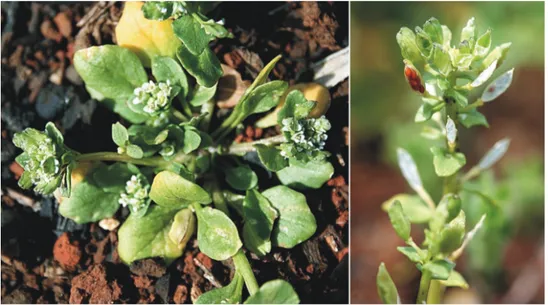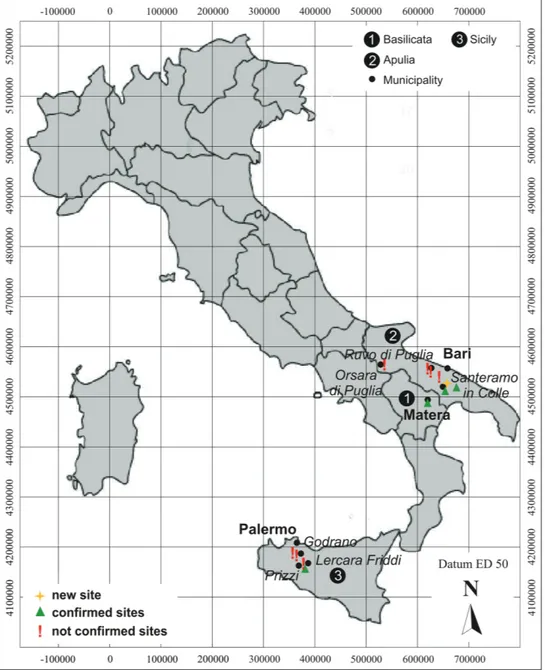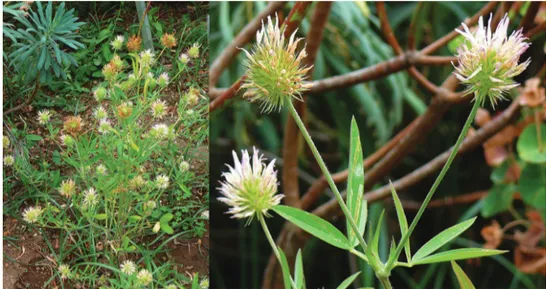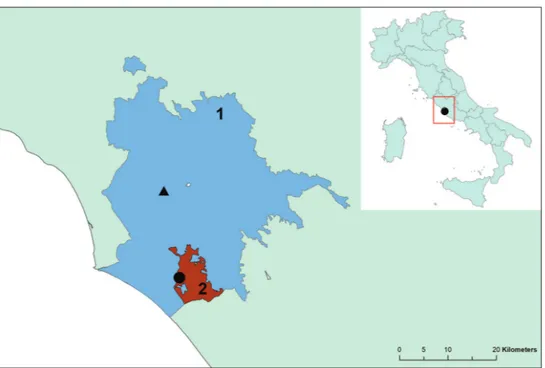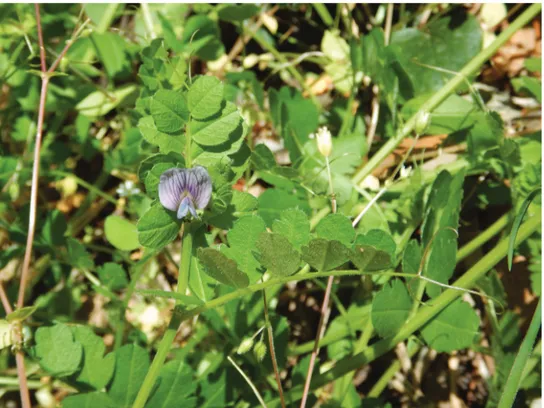Global and Regional IUCN Red List Assessments: 5
Simone Orsenigo1, Salvatore Cambria2, Alessandro Crisafulli3,Michele De Sanctis4, Giuliano Fanelli4, Matilde Gennai5, Vincenzo Gonnelli5,
Marta Latini4, Gianluca Nicolella4, Enrico V. Perrino6, Alessandro Serafini Sauli7,
Giuseppe N. Silletti8, Daniele Viciani5, Robert P. Wagensommer9, Giuseppe Fenu10
1 Department of Agricultural and Environmental Sciences - Production, Landscape, Agroenergy, University of
Milan, Milan, 20122, Italy 2 Department of Biological, Geological and Environmental Sciences, University of Catania, Via Antonino Longo 14, Catania, Italy 3 Department of Chemical, Biological, Pharmaceutical and Environmental Sciences, University of Messina, Via Stagno d’Alcontres 31, 98166 Sperone (ME), Italy
4 Department of Environmental Biology, Sapienza University of Rome, Piazzale Aldo Moro 5, Rome, Italy 5 Department of Biology, University of Florence, Via La Pira 4, 50121 Florence, Italy 6 CIHEAM –
Medi-terranean Agronomic Institute of Bari, Via Ceglie 9, 70010 Valenzano (BA), Italy 7 Regione Lazio, Direzione Regionale Risorse Idriche e Difesa del Suolo, Via del Tintoretto 432, 00142 Rome, Italy 8 Comando Regione Carabinieri Forestale Puglia, Via Lungomare Nazario Sauro 45, 70121 Bari, Italy 9 Department of Chemi-stry, Biology and Biotechnology, University of Perugia, Via del Giochetto 6, 06123 Perugia, Italy 10 Centre for the Conservation of Biodiversity (CCB), Department of Life and Environmental Sciences, University of Cagliari, Cagliari, 09123, Italy
Corresponding author: Simone Orsenigo ([email protected])
Academic editor: L. Peruzzi | Received 20 April 2018 | Accepted 14 May 2018 | Published 25 May 2018 Citation: Orsenigo S, Cambria S, Crisafulli A, De Sanctis M, Fanelli G, Gennai M, Gonnelli V, Latini M, Nicolella G, Perrino EV, Serafini Sauli A, Silletti GN, Viciani D, Wagensommer RP, Fenu G (2018) Global and Regional IUCN Red List Assessments: 5. Italian Botanist 5: 83–99. https://doi.org/10.3897/italianbotanist.5.26028
Abstract
In this contribution, the conservation status of four vascular plants according to IUCN categories and criteria are presented. It includes the assessment ofArceuthobium oxycedri (DC.) M.Bieb., Ionopsidium albiflorum Durieu, Trifolium latinum Sebast., and Vicia incisa M.Bieb. at a Regional level (Italy).
Keywords
conservation, extinction risk, IUCN protocol, threats
http://italianbotanist.pensoft.net
Copyright Simone Orsenigo et al. This is an open access article distributed under the terms of the Creative Commons Attribution License (CC BY 4.0), which permits unrestricted use, distribution, and reproduction in any medium, provided the original author and source are credited.
Regional Assessment (Italy)
Taxonomy and nomenclature Order: Santalales Family: Santalaceae
Arceuthobium oxycedri (DC.) M.Bieb., Fl. Taur.-Caucas. 3: 629. 1820 Common name: vischio del ginepro (It), juniper dwarf mistletoe (En)
Geographic distribution range: Arceuthobium oxycedri (Fig. 1) is present in many
countries bordering the Mediterranean Sea, in the Caucasus and central Asia (in many former Soviet republics), in the Indian subcontinent, and in western China (Ciesla et al. 2002). In Italy, A. oxycedri has been reported from several sites, all close to each other and located in a small area between eastern Toscana and western Marche, in the Provinces of Arezzo (nine localities) and Pesaro/Urbino (six localities) (Brilli-Cattarini and Gubellini 1983, Gonnelli and Scarponi 2003; Fig. 2).
Distribution: countries of occurrence: Afghanistan, Azerbaijan, Algeria, Albania, Armenia, Bosnia-Herzegovina, Bulgaria, China, Croatia, Cyprus, France, Georgia, Greece, India, Iran, Iraq, Italy, Kyrgyzstan, Lebanon, Macedonia, Montenegro, Mo-rocco, Pakistan, Portugal, Russia, Serbia, Slovenia, Spain, Syria, Tajikistan, Tunisia, Turkey, Turkmenistan, Ukraine, and Uzbekistan.
Biology: Plant growth form: woody perennial epiphyte, obligate parasite on Ju-niperus sp. pl. and other taxa belonging to Cupressaceae (in Italy only on JuJu-niperus communis L., J. oxycedrus L. and J. deltoides R.P.Adams). Dwarf mistletoe shoots have
chlorophyll, but with no photosynthetic significance (Hawksworth and Wiens 1996, Hawksworth et al. 2002).
Flowering time: late summer-early autumn (September to October).
Reproduction: Arceuthobium oxycedri is a dioecious plant that only reproduces
from seeds. Dispersal is promoted by the hydrostatic contraction of a mature fruit that propels a single, small seed upon ballistic flight to a near location, where a host may be inoculated. The dwarf mistletoes rely almost exclusively on this ballistic mechanism; however, birds and mammals may be important, for the rare, long-distance dissemi-nation of seeds (Hawksworth and Wiens 1996, Hawksworth et al. 2002). The dwarf
mistletoe does not produce shoots until two or three years following infection and flower production requires four or five years. Detailed information concerning estab-lishment, reproduction, and seed germination are reported in Hawksworth and Wiens (1996), Hawksworth et al. (2002), and Krasylenko et al. (2017).
Habitat and ecology: Arceuthobium oxycedri habitat and ecology depend strictly on
the host on which it lives. In Italy, it grows on J. communis, J. deltoides, and J. oxycedrus individuals located in open and degraded mixed oak woods and in shrubby grasslands, on marly-arenaceous and clay-calcareous soils, at altitudes between 500 and 1000 m a.s.l. (Gonnelli and Scarponi 2003). Shrubby grasslands on which A. oxycedri can be found in Italy generally correspond to the habitat “Juniperus communis formations on heaths or calcareous grasslands” (code 5130) of the Habitat Directive 92/43/EEC.
Population information: for Italy, there is no detailed information available on quantitative population estimation or on population dynamics and trends.
Threats: 2.3.2 Small-holder grazing, ranching or farming. Shepherds and farmers some-times cut junipers (hosting A. oxycedri of which they are unaware) to improve pastures.
7.3 Other ecosystem modifications. The agro-pastoral and forestry activities that de-grade the mixed oak woods in which A. oxycedri lives are abandoned in some areas, for socio-economic reasons; this increases the tree cover and reduces the possible oc-currence of junipers (which are rather heliophilous) within woods, consequently also of A. oxycedri. Currently, the absence of targeted management leads to the reduction of suitable sites for the persistence of the species; therefore, a decline in AOO, habitat quality, and number of individuals can be expected.
CRITERIA APPLIED:
Criterion B: EOO: 101.6 km2 calculated with minimum convex hull in QGis 2.14
AOO: 60 km2 calculated with a 2 × 2 km cell fixed grid
a) Number of locations: two locations have been identified according to threats 2.3.2 and 7.3. At present, four sites are not subjected to any threat, but any change in grazing Figure 2. Geographic range and distribution map of Arceuthobium oxycedri in Italy.
control or management could have negative impacts on all the growing sites within the same administrative region.
b) Decline in EOO (i), AOO (ii), quality and extent of habitat (iii), number of sub-populations (iv).
Red List category and Criteria (Regional Assessment)
Rationale for the assessment: Arceuthobium oxycedri is widespread especially in
central Asia, but in Italy it is found only in a few sites, all close to each other and lo-cated in a small area between eastern Toscana and western Marche. AOO and EOO are rather small and the Italian population is threatened by the abandonment of agro-pastoral and forestry activities in some locations and the intensity of agro-agro-pastoral activities in others. Due to the dispersal and reproduction mechanisms, the Italian populations are isolated from the populations of other countries and the loss of some local subpopulations cannot be easily recovered. For these reasons, this plant can be considered Endangered at a Regional level (Italy).
Previous assessment: Arceuthobium oxycedri was not previously evaluated (NE)
at Regional level for Italy, while it was assessed as Least Concern (LC) at global level (IUCN 2007).
Conservation actions: Arceuthobium oxycedri is not protected at either regional,
national or international levels. The Italian sites are not included in any protected area.
Conservation actions needed: further monitoring and research activities are rec-ommended in order to better understand the population trends of the species in Italy. Daniele Viciani, Vincenzo Gonnelli, Matilde Gennai
Ionopsidium albiflorum Durieu
Regional assessment (Italy)
Taxonomy and nomenclature Order: Brassicales Family: Brassicaceae
Ionopsidium albiflorum Durieu Rev. Bot. Recueil Mens 2: 433 (1847) ≡ Bivonaea al-biflora (Durieu) Prantl in Engler & Prantl, Nat. Pflanzenfam. 3(2): 166 (1891) ≡ Pastorea albiflora (Durieu) Tod. in Bertoloni, Fl. Ital. 10: 520 (1854).
Common name: White diamond flower (En)
Geographic distribution range: Ionopsidium albiflorum (Fig. 3) is distributed in the
southwestern Mediterranean Basin. Italian populations represent the northeastern limit of its range. In Italy, it is reported in Puglia, Basilicata and Sicilia, while its occurrence in Toscana is doubtful (Bartolucci et al. 2018). In Puglia, it has been observed in the
Figure 3. Ionopsidium albiflorum photographed in Santeramo in Colle (Bari). Picture by E.V. Perrino
and G.N. Silletti.
lowing localities: between Masseria Plantamura and Bosco di Morazia (Perrino et al. 2013), and at Masseria Simone (25.4.2015, E.V. Perrino, G.N. Silletti, 40491, BI), both located in the Santeramo in Colle (Bari) municipality; Martina Franca (Bari) (Silletti 2013); Par-co del Conte (18.1.1897, 31.1.1898, 23.2.1898, A. Palanza, 44390, BI), BosPar-co Caputi (14.2.1897, 15.2.1899, A. Palanza 44389, BI) in the municipality of Ruvo di Puglia (Bari), Bosco Scacchiavolpe (21.2.1897, A. Palanza, 44390, BI) in the municipality of Cassano Murge (Bari) (Palanza 1900); Bosco Acquara in the municipality of Orsara di Puglia (Fog-gia) (Trotter and Romano 1914). The presence in the stations of Parco del Conte, Bosco Caputi, Bosco Scacchiavolpe, and Bosco Acquara is no longer confirmed. In Basilicata, the species was observed only in the Regional Park of “Murgia Materana” (Matera) (Medagli and Gambetta 2003). In Sicilia, it is reported in four localities in the province of Palermo, three of them by Lojacono-Poiero (1888-1908) have not been recently confirmed: Alpe Cucco and Bosco del Cappelliere, in the municipalities of Godrano and Marineo, respec-tively; Nicolosi in the municipality of Lercara Friddi. The fourth site (Marcenò et al. 1985) refers to Cozzo Padorno on Mt. Sicani in the municipality of Prizzi. Only the five sites recorded in the last 35 years have been used for the assessment, excluding the other seven for which there has been no confirmation for more than 100 years (Fig. 4).
In Toscana, its presence should be considered highly doubtful, because the only known herbarium specimen is very old and was collected as I. savianum (Caruel) Arcang. (originally determined as Bivonaea saviana Caruel by Forsyth Major in April 1883, from Mt. Calvi), and then revised in a genetic study as I. albiflorum Durieu (Koch 2012).
Distribution: Countries of occurrence: Algeria, Italy, Morocco, and Tunisia
Biology: Plant growth form: annual (therophyte) Flowering time: from March to April
Figure 4. Geographic range and distribution map of Ionopsidium albiflorum in Italy.
Reproduction: no information on pollination strategy and seed germination is available.
Habitat and Ecology: Ionopsidium albiflorum typically grows on uncultivated
meadows up to about 800 m a.s.l.
Population information: There is no detailed information available on popula-tion dynamics. It is noteworthy that the 30 individuals observed in the spring of 2009
CRITERIA APPLIED:
Criterion B: AOO: 20 km2 calculated with a 2×2 km cell fixed grid
EOO: 8,794 km2 calculated with minimum convex hull (with Google
Earth Pro)
a) Number of locations: four (according to threat 7.3)
b) Documented decline in EOO (i), AOO (ii), number of subpopulations (iv) c) Extreme fluctuations in number of mature individuals (iv)
Red List category and Criteria (Regional Assessment)
EN Endangered B2ab(i,ii,iv)c(iv)
Rationale for the assessment: in Italy, I. albiflorum is found in Puglia, Basilicata, and Sicilia. It has an AOO of 20 km2, four locations have been identified, a decline has been
documented in EOO, AOO, and number of subpopulations, and extreme fluctuations in number of mature individuals have been observed. Therefore, it is classified as Endangered.
Previous assessment: At a Regional level, the species was assessed as Critically En-dangered (CR) in Puglia, EnEn-dangered (EN) in Sicilia, and Vulnerable (VU) in Basilicata (Conti et al. 1997). No assessment at global level of the species exists (IUCN 2017).
Conservation actions: The sites, except that of Masseria Simone and Parco del Conte, are included in the following protected areas: National Park of “Alta
Mur-gia”, SAC/SPA IT9120007 “Murgia Alta”, SAC IT9110032 “Valle del Cervaro Bosco dell’Incoronata” (Puglia), SAC/SPA IT9220135 “Gravine di Matera”, Regional Park
of the “Murgia Materana” (Basilicata), SPA ITA020048 “Monti Sicani, Rocca
Busam-bra e Bosco della Ficuzza”, SAC ITA020031 “Monte d’Indisi, Montagna dei Cavalli, Pizzo Pontorno e Pian del Leone” (Sicilia). Currently, there are no conservation actions
for this extremely rare species.
Conservation actions needed: It would be useful to start in situ and ex situ conser-vation actions, in addition to research activities on population monitoring in all Italian administrative regions where the species is reported, in order to better understand the species’ reproductive biology, ecology, level of threat, and population trend.
Enrico Vito Perrino, Robert Philipp Wagensommer, Alessandro Crisafulli, Giuseppe Nicola Silletti
Trifolium latinum Sebast.
Regional assessment (Italy)
Taxonomy and nomenclature Order: Fabales Family: Fabaceae
Trifolium latinum Sebast. in Plantae Romanae 1, 7 (1813) Common name: Trifoglio latino (It).
Geographic distribution range: Trifolium latinum (Fig. 5) grows in Bulgaria, northern Greece, European Turkey (Kozuharov 1976, Zohary 1970, Zohary and Hel-ler 1984), and Italy, where it was described from a small area in the SW suburbs of Rome (Tenuta dei Massimi) in 1813 (Sebastiani 1813, Sebastiani and Mauri 1818). According to the material in the Herbarium Romanum, the species was collected in the same area until the end of the 19th century; it was then believed extinct in Italy (Pignatti 1982, Iamonico et al. 2011) until its rediscovery in a different, but nearby, locality in the Decima-Malafede Regional Park of the Municipality of Rome (Fanelli et al. 2012; Fig. 6). The species was described as rare in the historical record; the cur-rent range is also restricted to a small stretch of no more than 50 m in the coppices of
Quercus frainetto Ten. and Quercus cerris L., along a dirt road.
Distribution: Countries of occurrence: Bulgaria, Greece, Italy, European Turkey.
Biology: Plant growth form: annual (therophyte).
Flowering and fruiting time: Flowering in May and extending into early June.
Reproduction: Dispersal by seeds. Seeds seem to form a seed bank, since the spe-cies re-grew abundantly after the almost total destruction of the population in 2015, but it was not possible to assess the longevity of seeds in soils.
Figure 5. Trifolium latinum photographed in the Decima-Malafede Regional Park (Rome, Italy). Picutre
Figure 6. Occurrence of Trifolium latinum. The black circle marks the current population; the black
triangle indicates the historical site. 1: Municipality of Rome; 2: Decima-Malafede Regional Park. Habitat and ecology: It grows in the fringes and clearings of sub–Mediterranean deciduous forests dominated by Quercus cerris-Q. frainetto in moderate shadow on subacid sandy soils (Fanelli et al. 2012).
Population information: The Italian population was monitored from 2012 onwards. The extent of occurrence is about 60 m2, whereas the AOO is less than 40
m2. These seem rather stable due probably to the presence of a persistent soil seed
bank. The population is, instead, declining: in 2012 it comprised 391 flowering in-dividuals, in 2013 it was not monitored, 241 individuals were counted in 2014 and in 2015 it was almost exterminated (only three individuals) due to the ploughing of the white road along which the species grows by the owner of the area; it recovered in 2016 (103 individuals) and in 2017 counted 112 individuals. Although the spe-cies survived the inconsiderate destruction of its habitat, its population decreased by 71%.
Threats: 7.3 Other ecosystem modification: the population was almost exterminated
in 2015 due to ploughing of the dirt road where the species occurs. This intervention was motivated with the need to prevent fire expansion in the woodland; the risk is still present due to current forestry practices in the area.
11.1 Habitat shifting and alteration: the population seems to be related to a
particular microclimate, which could explain the extremely restricted AOO of the population and the absence in apparently suitable and similar habitats in the same area. Climate change can alter these microclimatic conditions, thus decreasing or extinguishing the population.
CRITERIA APPLIED:
Criterion B: AOO: 4 km2 calculated with a 2×2 km cell fixed grid
a) Number of locations: one, since the species occur in a single locality
b) Decline in quality and extent of habitat (iii); the number of individuals is subjected to continuous decline (more than 70%) since its discovery in 2011 (iv).
Criterion D: The number of mature individuals is less than 250 in the years follow-ing the species’ rediscovery in Italy.
Red List category and Criteria (Regional Assessment)
Rationale for the assessment: In Italy, the species is present in a single locality with an AOO of 4 km2, however the area actually occupied by the species is limited to a few
dozen square metres. The ongoing threats to the only known population, the decline in quality of the habitat and the decline in number of mature individuals support classifica-tion of the species as Critically Endangered according to the formula B2ab(iii, iv).
Previous assessment: Extinct at the Regional level in Italy (Conti et al. 1992).
Conservation actions: Trifolium latinum is not protected under either national or regional laws. The species occurs in the Decima–Malafede Regional Park and in the SCI “Sughereta di Castel di Decima” IT6030053, but the area is privately owned and no specific conservation measures have been applied, even though the Park was imme-diately informed of the existence of this critically endangered species.
Conservation actions needed: For this population to persist, the habitat must not be altered, which means that the particular microclimate and shading conditions must be preserved. No forestry practice should be allowed in the forest on the fringe of which the species occurs, with an area of respect of at least 2 km2. A moderate disturbance is needed
to preserve the species from competition with shrub species, since T. latinum is a species of clearings and fringes. Regular mowing at intervals of three-four years should be performed in the stretch of white road where the species occurs, but ploughing and, in general, the pas-sage of machines should be absolutely avoided. Ex situ conservation in the seed bank of the Botanical Garden of Rome should continue and germination tests should be carried out.
Giuliano Fanelli, Michele De Sanctis, Alessandro Serafini Sauli
Vicia incisa M.Bieb.
Regional assessment (Italy)
Taxonomy and nomenclature Order: Fabales Family: Fabaceae.
Vicia incisa M.Bieb., Fl. Taur.-Caucas. 3: 471. 1819 ≡ Vicia sativa L. var. incisa (M.Bieb.)
Boiss., Fl. Orient. 2: 574. 1872 ≡ Vicia sativa L. subsp. incisa (M.Bieb.) Arcang., Comp. Fl. Ital.: 201. 1882 = Vicia pimpinelloides Mauri, Roman. Pl. Cent. XIII: 35. 1820. CR Critically Endangered B2ab(iii,iv)
Common name: Veccia incisa (It), Incised vetch (En), Goroshek Nadrezannyi (Ru)
Geographic distribution range: Vicia incisa (Fig. 7) has a SE-Europe-Pontic
dis-tribution range. In Italy, the species occurs exclusively in two administrative regions: Lazio and Sicilia (Fig. 8). In Lazio, V. incisa is present only at Castelli Romani (Abbate et al. 2009, Anzalone et al. 2010). Here, the species was repeatedly collected at Albano Laziale and Castel Gandolfo in 1827 and 1854; later, it was not recorded for a long period and was re-discovered in the same sites only in 1982 (Anzalone 1983). During field surveys conducted in 2017, only two populations were observed at Castelli Rom-ani along the road edges near chestnut woodlands, while a third population, growing in woodland clearings (P. Bassani, pers. comm.), was not recorded. The species was also cited by Mauri (1820) and by other Italian botanists (e.g., Arcangeli 1882) for Casetta Mattei (western areas of the city of Rome), but also this locality was not confirmed (Iberite et al. 2017). In Sicilia, the species occurs in Castiglione di Sicilia, where it was first discovered and collected in 1998 (Cristaudo and Margani 2005), but this popula-tion was not observed during field surveys in 2017; conversely, another populapopula-tion was discovered about 1 km away in the same municipality, on private land at C. Sangenisi.
Distribution: Countries of occurrence: Bulgaria, Crimea, Greece, Italy, Turkey.
Biology: Plant growth form: annual herb (therophyte). Chromosome number: 2n = 14 (Roti Michelozzi and Barberis 1989; Meriç and Dane 1999).
Figure 8. Distribution map of Vicia incisa in Italy.
Flowering and fruiting time: Flowering from April to May, fruiting from May to June (in Italy).
Reproduction: Insect pollination, barochorus dispersion.
Habitat and Ecology: In Italy, Vicia incisa occurs at 300-600 m a.s.l. in clearings of deciduous oak/chestnut woodlands and along road margins on volcanic soils.
Population information: Italian populations are in decline: extinction events oc-curred both in historical (Casetta Mattei) and recent times (one population in Castelli Romani). There is no detailed information on population dynamics, but the number of mature plants can be estimated at about 100 individuals for both Castelli Romani and C. Sangenisi populations.
Threats: 1.1 Housing & Urban Areas: the populations in Lazio are threatened by
expansion of urban areas.
4.1 Roads & Railroads: in Lazio, the plants grow on the border or very close to
Criterion D: Number of mature individuals < 250.
Red List category and Criteria (Regional Assessment):
EN Endangered B1ab(iii,iv,v) + B2ab(iii,iv,v) + D
Rationale for the assessment: In Italy, Vicia incisa is found exclusively in two re-gions (Lazio and Sicilia), with an EOO of 1,967 km2 and an AOO of 16 km2. Only three
populations are currently known, two in Lazio and one in Sicilia. The total number of mature individuals is estimated at about 200. Because of its rarity, the decline in quality and extent of habitat and in the number of locations, combined with the low number of mature individuals, this taxon qualifies as EN Endangered. B1ab(iii,iv,v) + B2ab (iii,iv,v) + D in accordance with assessment reported above.
Previous assessment: Previously listed at national (Italy) level as CR (Rossi et al. 2013), while at a global level the species was not evaluated (IUCN 2017).
Conservation action: The populations at Castelli Romani occur within the Cas-telli Romani Regional Park; moreover, the population at Castel Gandolfo is included in SIC IT6030039 “Albano (Località Miralago)”. The Sicilian population is not currently subject to any official protection measures, since its only stand does not fall within the nearby Etna Regional Park nor a SIC of the Natura 2000 network. However, it is located on private land, whose owner has been protecting it for several years from grazing and fires, which probably caused the disappearance of the other previously known station.
Conservation action needed: Research activities and monitoring programmes are recommended to better understand the population trends of the species; further field searches for other stations are also suggested.
Marta Latini, Gianluca Nicolella, Salvatore Cambria
Acknowledgements
Many thanks are due, concerning Vicia incisa, to P. Bassani for sharing his knowledge of the populations in Lazio, to A. Cristaudo for field research in Sicily and to F. Russo for allowing us to visit the C. Sangenisi locality.
References
Abbate G, Bonacquisti S, Giovi E, Iamonico D, Iberite M, Lorenzetti R (2009) Contribution to the vascular flora of the Castelli Romani Regional Park (Rome, Central Italy) with recent observations and early herbarium surveys. Webbia 64(1): 47–74. https://doi.org/10.1080 /00837792.2009.10670852
Anzalone B (1983) Note di flora romana: su alcune specie nuove o «ritrovate» nel Lazio. Infor-matore Botanico Italiano 15(1): 13–17.
Anzalone B, Iberite M, Lattanzi E (2010) La flora vascolare del Lazio. Informatore Botanico Italiano 42(1): 187–317.
Arcangeli G (1882) Compendio della Flora Italiana. Ermanno Loescher, Torino.
Bartolucci F, Peruzzi L, Galasso G, Albano A, Alessandrini A, Ardenghi NMG, Astuti G, Bac-chetta G, Ballelli S, Banfi E, Barberis G, Bernardo L, Bouvet D, Bovio M, Cecchi L, Di Pietro R, Domina G, Fascetti S, Fenu G, Festi F, Foggi B, Gallo L, Gottschlich G, Gubel-lini L, Iamonico D, Iberite M, Jiménez-Mejías P, Lattanzi E, Marchetti D, Martinetto E, Masin RR, Medagli P, Passalacqua NG, Peccenini S, Pennesi R, Pierini B, Poldini L, Pros-ser F, Raimondo FM, Roma-Marzio F, Rosati L, Santangelo A, Scoppola A, Scortegagna S, Selvaggi A, Selvi F, Soldano A, Stinca A, Wagensommer RP, Wilhalm T, Conti F (2018) An updated checklist of the vascular flora native to Italy. Plant Biosystems 152(2): 179–303. https://doi.org/10.1080/11263504.2017.1419996
Brilli-Cattarini AJB, Gubellini L (1983) Segnalazioni Floristiche Italiane: 138. Arceuthobium
oxycedri (DC.) Bieb. Informatore Botanico Italiano 13 (1981): 203.
Ciesla WM, Geils BW, Adams RP (2002) Hosts and geographic distribution of Arceuthobium
oxycedri. RMRS-RN-11WWW. Fort Collins, CO: U.S. Department of Agriculture, Forest
Service, Rocky Mountain Research Station. https://doi.org/10.2737/RMRS-RN-11 Conti F, Manzi A, Pedrotti F (1992) Libro rosso della flora d’Italia. Associazione Italiana per il
World Wildlife Found, Roma.
Conti F, Manzi A, Pedrotti F (1997) Liste Rosse Regionali delle Piante d’Italia. World Wildli-fe Fund (WWF) Italia, Società Botanica Italiana (SBI), Centro Interdipartimentale Au-diovisivi e Stampa, Università di Camerino. Camerino: Tipar Poligrafica Editrice. 1–139. Cristaudo A, Margani I (2005) Specie nuove o interessanti per la Flora Siciliana. Informatore
Botanico Italiano 37(2): 1153–1159.
Fanelli G, De Sanctis M, Serafini Sauli A (2012) La riscoperta di Trifolium latinum (Fabaceae) in Roma un secolo dopo la sua apparente sparizione dall’Italia. Informatore Botanico Ita-liano 44: 337–339.
Gonnelli V, Scarponi A (2003) Prima segnalazione di Arceuthobium oxycedri (DC) Bieb. in Romagna e nuovi dati distributivi in Italia. Quaderni di Studi e Notizie di Storia Naturale della Romagna 4: 1–6.
Hawksworth FG, Wiens D (1996) Dwarf mistletoes: Biology, pathology and systematic Agricultural Handbook 709. US Dept of Agriculture, Forest Service, Washington, DC, 410 pp. https://wwwfsfedus/rm/pubs_other/rmrs_1996_hawksworth_f001pdf
Hawksworth FG, Wiens D, Geils BW (2002) Arceuthobium in North America In: Geils BW, Cibrián TJ, Moody B (Eds) Mistletoes of North American Conifers Gen Tech Rep
RMRS-IUCN (2017) The RMRS-IUCN Red List of threatened species. Version 2017-1. http://www.iucn-redlist.org [accessed on 2017/07/27]
Koch MA (2012) Mid-Miocene divergence of Ionopsidium and Cochlearia and its impact on the systematics and biogeography of the tribe Cochlearieae (Brassicaceae). Taxon 61(1): 76–92.
Kozuharov SI (1976) Trifolium L. In: Jordanov D (Ed.) Flora Reipublicae Popularis Bulgaricae 6. Bulgarian Academy of Sciences, Sofia, 327–441.
Krasylenko YA, Janošíková K, Kukushkin OV (2017) Juniper dwarf mistletoe (Arceuthobium
oxycedri) in the Crimean Peninsula: novel insights into its morphology, hosts, and
distribu-tion. Botany 95: 897–911. https://doi.org/10.1139/cjb-2016-0289 Lojacono-Poiero M (1888–1908) Flora sicula 1. Palermo.
Marcenò C, Colombo P, Princiotta R (1985) Ricerche climatologiche e botaniche sui Monti Sicani (Sicilia centro occidentale). Naturalista siciliano 4(8): 69–133.
Mauri E (1820) Romanarum Plantarum Centuria Decimatertia. Typis De Romanis, Romae. https://doi.org/10.5962/bhl.title.119540
Medagli P, Gambetta G (2003) Guida alla Flora del Parco. Parco Regionale della Murgia Materana, Matera, Italy.
Meriç Ç, Dane F (1999) Karyological studies on Vicia sativa L. subsp. incisa (Bieb.) Arc. var.
incisa. Turkish Journal of Botany 23: 63–67.
Palanza A (1900) Flora della Terra di Bari. In: Jatta A (Ed.) La Terra di Bari, III. Tipografia Editore V. Vecchi, Trani, 1–90.
Perrino EV, Wagensommer RP, Silletti GN, Signorile G, Angiulli F (2013) Nuovi dati distribu-tivi e relazione con la Direttiva 92/43/CEE di taxa critici pugliesi dalla Provincia di Bari. Informatore Botanico Italiano 45(1): 53–62.
Roti Michelozzi G, Barberis G (1989) Biosystematic notes on Vicia incisa M.Bieb. (Legumino-sae), a rare species for Italy. Atti della Società Toscana di Scienze Naturali, Memorie, serie B 96: 219–225.
Sebastiani A (1813) Romanarum Plantarum fasciculus primus. Typis de Romanis, Romae. Sebastiani E, Mauri A (1818) Florae Romanae Prodromus exhibens centurias XII plantarum
circa Romam et in cisappenninis Pomntificiae Ditionis porvinciis sponte nascentium sexuali systemate digestas. Poggioli r.c.a., Roma, 351 pp.
Silletti NG (2013) Flora della Riserva Naturale Orientata “Murge Orientali”. Corpo Forestale dello Stato. Ufficio Territoriale per la Biodiversità. Martina Franca. 121 pp.
Trotter A, Romano M (1914) Sulla Flora di Monte Crispiniano in Puglia. Nuovo Giornale Botanico Italiano n.s. 21(4): 398–435.
Zohary M (1970) Trifolium L. In: Davis PH (Ed.) Flora of Turkey and the East Aegean Islands. Vol. 3. Edinburgh university Press, Edinburgh, 645 pp.
Zohary M, Heller D (1984) The genus Trifolium. The Israel Academy of Sciences and Humanities, Jerusalem, 606 pp.

